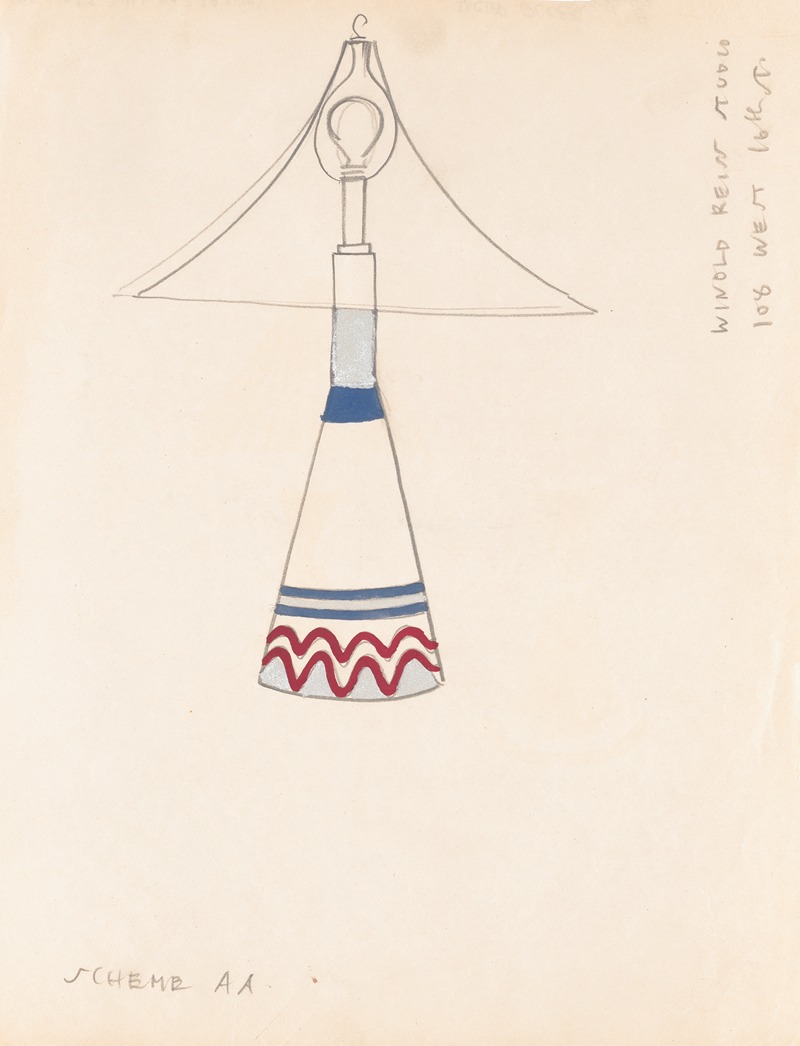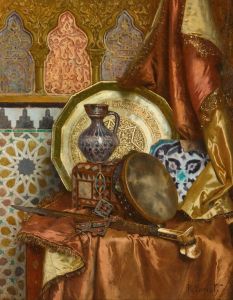
Designs for lamps with triangular shades.] [Design with white, red, and metallic silver
A hand-painted replica of Winold Reiss’s masterpiece Designs for lamps with triangular shades.] [Design with white, red, and metallic silver, meticulously crafted by professional artists to capture the true essence of the original. Each piece is created with museum-quality canvas and rare mineral pigments, carefully painted by experienced artists with delicate brushstrokes and rich, layered colors to perfectly recreate the texture of the original artwork. Unlike machine-printed reproductions, this hand-painted version brings the painting to life, infused with the artist’s emotions and skill in every stroke. Whether for personal collection or home decoration, it instantly elevates the artistic atmosphere of any space.
Winold Reiss was a German-American artist and designer known for his contributions to modern design and his role in popularizing modernist aesthetics in the United States during the early to mid-20th century. Born in Karlsruhe, Germany, in 1886, Reiss immigrated to the United States in 1913. He brought with him a European sensibility that blended traditional craftsmanship with modernist principles, which he applied across various media, including painting, graphic design, and interior design.
Reiss's work is characterized by its vibrant use of color, geometric forms, and a keen attention to detail. His designs often incorporated elements of Art Deco, a style that was gaining popularity during his time. Art Deco is known for its bold geometric patterns, rich colors, and luxurious materials, all of which can be seen in Reiss's work. His ability to integrate these elements into functional design objects made him a sought-after designer in the United States.
One of Reiss's notable contributions to design was his work with lamps, particularly those featuring triangular shades. The design of these lamps often included a combination of white, red, and metallic silver, showcasing Reiss's skillful use of color and form. These lamps were not only functional but also served as decorative art pieces, reflecting the modernist ethos of blending art with everyday life.
Reiss's lamp designs were part of a broader movement during the early 20th century that sought to redefine the role of decorative arts in modern living. By using materials such as metal and glass, and employing geometric shapes, Reiss's designs aligned with the contemporary trends of the time, which emphasized simplicity, functionality, and elegance. The choice of colors—white, red, and metallic silver—added a dynamic visual impact, making these lamps stand out in any interior setting.
In addition to his work with lamps, Winold Reiss was also known for his portraits and murals. He gained recognition for his portraits of Native Americans, African Americans, and other cultural groups, which were notable for their respectful and vibrant representation. His murals, often commissioned for public spaces such as hotels and restaurants, further demonstrated his ability to merge art with architecture and interior design.
Reiss's influence extended beyond his own creations. He was a teacher and mentor to many young artists and designers, and his work helped pave the way for the acceptance and integration of modernist design in American culture. His legacy is reflected in the continued appreciation of Art Deco and modernist design principles in contemporary art and design.
Overall, Winold Reiss's designs for lamps with triangular shades exemplify his innovative approach to design and his ability to blend artistic expression with functional objects. His work remains an important part of the history of modern design, illustrating the transformative power of art in everyday life.







![Designs for Indian Room, Chic-n-Coop Restaurant, Montreal, Canada.] [Placemat design with chicken character wearing crown](/imgs/249244/s/winold-reiss-designs-for-indian-room-chicncoop-restaurant-montreal-canada-placemat-design-with-chicken-character-wearing-crown-67b965b8.jpg)
![Design for fine art print, ‘The Mad Dancer’.] [Woodcut print](/imgs/249286/s/winold-reiss-design-for-fine-art-print-the-mad-dancer-woodcut-print-c03b5ea2.jpg)

![Graphic designs for Fortune magazine.] [Studies for cover drawn on black paper](/imgs/249355/s/winold-reiss-graphic-designs-for-fortune-magazine-studies-for-cover-drawn-on-black-paper-4ae65d38.jpg)
![Interior design drawings for unidentified rooms.] [Sketch for unidentified room with silver wall and ceiling](/imgs/249362/s/winold-reiss-interior-design-drawings-for-unidentified-rooms-sketch-for-unidentified-room-with-silver-wall-and-ceiling-af719bb9.jpg)
![Interior perspective drawings of Hotel Siwanoy, Mount Vernon, NY.] [Interior perspective of dining room](/imgs/249368/s/winold-reiss-interior-perspective-drawings-of-hotel-siwanoy-mount-vernon-ny-interior-perspective-of-dining-room-d26480cd.jpg)
![Proposed decorations for Fisher Building, Detroit.] [Theatre foyer 109 & adjacent galleries](/imgs/249387/s/winold-reiss-proposed-decorations-for-fisher-building-detroit-theatre-foyer-109-adjacent-galleries-88035d64.jpg)
![Miscellaneous small sketches for inlaid table tops.] [Design with circular and geometric motif](/imgs/249433/s/winold-reiss-miscellaneous-small-sketches-for-inlaid-table-tops-design-with-circular-and-geometric-motif-3afe4da6.jpg)
![Miscellaneous small sketches for inlaid table tops.] [Design with zig-zag motif](/imgs/249443/s/winold-reiss-miscellaneous-small-sketches-for-inlaid-table-tops-design-with-zigzag-motif-dbbaeb35.jpg)

